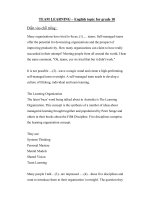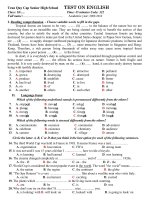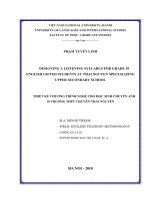TEAM LEARNING – English topic for grade 10
Bạn đang xem bản rút gọn của tài liệu. Xem và tải ngay bản đầy đủ của tài liệu tại đây (209.9 KB, 11 trang )
TEAM LEARNING – English topic for grade 10
Điền vào chỗ trống :
Many organizations have tried to focus..(1)..... teams. Self-managed teams
offer the potential for downsizing organizations and the prospect of
improving productivity. How many organizations can claim to have really
succeeded in their attempt? Meeting people from all around the world, I hear
the same comment, "Oh, teams, yes we tried that but it didn't work."
It is not possible ....(2)...wave a magic wand and create a high-performing,
self-managed team overnight. A self-managed team needs to develop a
culture of lifelong, individual and team learning.
The Learning Organization
The latest 'buzz' word being talked about in Australia is The Learning
Organization. This concept is the synthesis of a number of ideas about
managerial learning brought together and popularized by Peter Senge and
others in their books about the Fifth Discipline. Five disciplines comprise
the learning organization concept.
They are:
Systems Thinking
Personal Mastery
Mental Models
Shared Vision
Team Learning
Many people I talk ...(3)...are impressed .....(4)....these five disciplines and
want to introduce them to their organization 'overnight'. The question they
always ask me is, "Where do I start?"
My answer is, "Start with Team Learning. It is a process you can commence
tomorrow and it just may help you prevent your self-managed team strategy
from failing."
What is Team Learning?
Team Learning is an adaptation ....(5)....action learning originally proposed
in the UK by Reg Revans many years ago and recently re-discovered by
organizational development consultants in the USA. It focuses on providing
solutions to business problems by developing an open approach to
questioning. As Reg Revans himself once said, "The mark of a leader is not
the answers he gives but the questions he asks." The business world is
changing at such a pace that the solutions to problems are not found in books
or journals, nor in the mind of 'the expert'. They are found by team members
themselves, who, through the process of Team Learning, identify the key
questions to be addressed. They then seek to use their resources to find the
answers, often through trial and error.
The concepts of team-learning can be broken down into four key
components:
Questioning
Valuing Diversity
Communicating
Learning Review
Questioning
When faced ........(6)..... a problem, a new project or an opportunity, it is a
good idea to focus on the nine key success factors which make the difference
between a high-performing team and a low-performing team. These factors
are arranged in a model of team tasks, known as The Types of Work Wheel.
This Wheel describes nine essential team activities as:
Advising - Gathering and reporting information
Innovating - Creating and experimenting with ideas
Promoting - Exploring and presenting opportunities
Developing - Assessing and testing the applicability of new approaches
Organizing - Establishing and implementing ways of making things work
Producing - Concluding and delivering outputs
Inspecting - Controlling and auditing the working of systems
Maintaining - Upholding and safeguarding standards and processes
Linking - Coordinating and integrating the work of others
These factors form the basis for a methodology of questioning.
When faced with a difficult problem, the starting point for team discussion is
Advising. What information do we need? Why? Where will we get it? Who
will get it? When do we need it? How will we get it? This ensures that all
currently available data is gathered for consideration.
The Innovating sector ensures that the team will spend time discussing ideas
around the problems being faced. Most successful innovating sessions
follow a procedure designed to ensure an open and diverging discussion.
Such sessions should be free from any commitment to make a decision. That
comes later.
Promoting has two aspects ......(7).... it. Each team member needs to learn
how to present ideas and solutions in a way that will influence other team
members. Equally important is a focus on the key stakeholders outside the
team. Who outside the team needs to be persuaded if the idea is to proceed?
Many ideas are impracticable and can never be implemented, due to
organizational and cultural constraints. Developing sessions focus on which
ideas are likely to work and how can they be tested for verification.
Organizing is action oriented and ensures that the team will implement
agreed solutions and assign accountabilities and responsibilities. It is
predictably colored red - the color of action.
Producing addresses the output aspects of any decision. What are we
producing? To what quality levels? To what standards? When? Producing
defines the bottom line on which many teams are evaluated.
How many ideas fail because the detailed aspects were not thought through?
Unforeseen contractual problems arise, financial difficulties occur, security
issues eventuate, computer errors appear. Many ....(8).... these Inspecting
problems can be eliminated by focusing discussion on this aqua-blue aspect
of work. Blue is the color ............(9)...cool, clear, detailed thinking.
Maintaining the agreed decisions and the team processes will ensure that the
team stays together and learns together. Your car will fail if it doesn't have a
regular 10,000 Km service. Your team will fail if it is not maintained.
Maintenance involves regularly reviewing mistakes in a non-recriminatory
way and establishing guidelines to prevent them from reoccurring.
Linking is ......(10) the middle of the model because it is a shared
responsibility of every team member. Each person working on a team task
must undertake to link with other team members so that everyone is fully
informed.
This model should be the basis for any Team Learning processes established
in your organization. It provides a structure and a language to ensure that the
essential activities for excellence in teamwork are continually implemented.
Many successful learning teams structure their meetings into four basic
sessions, rather than attempting to cover everything in one sitting. Green
meetings focus on information; yellow meetings concentrate on
opportunities, red meetings implement plans and blue meetings check details
and review progress
Valuing Diversity
Diversity of thinking is one of the hallmarks of learning teams. Problems
need to be viewed............(11).. different angles if the best solutions are to be
generated. If everyone looks at problems in the same way then group think
can occur. If diversity is allowed and encouraged, then better solutions will
result.
However the downside of diversity is conflict. Different viewpoints will
inevitably lead to disagreement and it is only the committed learning team
that can use the diversity of views in a positive way.
Many of the work content issues of diversity can be addressed through a
preference model like the Team Management Wheel. This model highlights
the different ways that team members like to approach work situations. The









